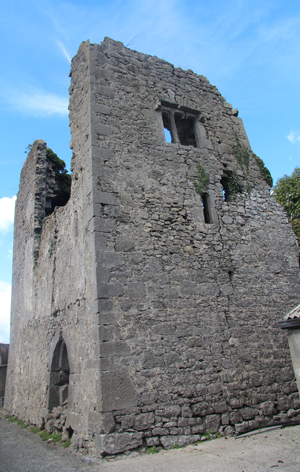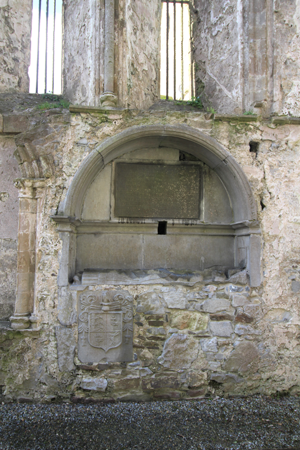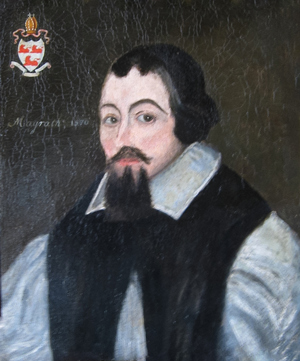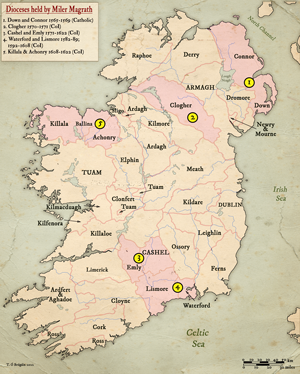MILER MAGRATH, THE ENIGMATIC ARCHBISHOP
Published in Features, Issue 1 (January/February 2023), Volume 31By Patrick J. Ryan
Reprobate, rogue, scoundrel, contentious, devious and greedy are just some of the many epithets used to describe Miler Magrath, archbishop of Cashel from 1571 to 1622. Ever since he became a Protestant bishop in 1570 he has been reviled and scapegoated, but he has also been given accolades such as ‘great politician’, a ‘man of gravity and learning’, a diplomat and ‘a good servant to her majesty’. Who was this man who played such a pivotal role in the ecclesiastical and political life of sixteenth–seventeenth-century Ireland?
Miler Magrath rose to prominence after the Council of Trent (1545–63), which began the Catholic Church’s Counter-Reformation. Trent made it clear that the prime responsibility for reforming the Catholic Church lay with the bishops. As the council ended, the dioceses of Armagh and Down and Connor were vacant and Shane O’Neill, who controlled Ulster, sought to have his nominees appointed to both. Rome refused and chose two people who met the new criteria of Trent—Richard Creagh of Limerick as archbishop of Armagh in March 1564, and Miler Magrath as bishop of Down and Connor in October 1565.
COUSIN OF SHANE O’NEILL
Miler Magrath had given evidence of being committed to reform of the Catholic Church. Born in Carn, Co. Donegal, about 1522, he was descended from a long line of coarbs of Termon Magrath in Clogher diocese. Coarbs were pillars of the church with major roles in diocesan finances, hospitality and education. For centuries they had provided many committed people to the service of the church, and among Miler’s contemporaries were a number of highly educated religious committed to the renewal of the church, among them the Observant Franciscans Fr Brian Bocht Magrath, preacher and miracle-worker, and the preacher Fr Seán Gruama Magrath. Miler had joined the Conventual Franciscans and was already well acquainted with Rome and with those who counted. As well as being vouched for by his Franciscan superiors in Rome, he was vouched for by the influential secretary general of the Jesuits, Juan de Polanco, who commended him as ‘diligent’, ‘reliable’, ‘zealous’ and ‘worthy to be promoted to the episcopate’. Polanco assured Archbishop Creagh that Miler ‘would be of immense help to him in promoting the church’ in Ulster and, as a bonus point, Miler was related to the O’Neills, being a cousin of Shane O’Neill. Miler had received a Gaelic and classical education in Ireland and probably studied in Rome and Spain. His subsequent work in Rome, Spain, the Netherlands and Ireland would have acquainted him with the thinking of Protestant reformers such as Luther and Calvin.
On returning to Ulster in 1566, Miler attended a conference in August with Archbishop Creagh and Shane O’Neill, who was in rebellion against the English. Creagh’s refusal to preach a crusade against the English and disagreement on other major issues led to his being branded a heretic by Shane and Miler. Miler and Shane wrote letters to Rome and Spain accusing Creagh of heresy. Ironically, Creagh was arrested by the English and imprisoned in the Tower of London in April 1567.
Shane’s rebellion collapsed and he was assassinated in June 1567. Miler then sought the protection of his kinsman Cúconnacht Maguire of Fermanagh and submitted to Lord Deputy Sidney, taking the oath of allegiance to Queen Elizabeth I.
Supported by Maguire, Miler went to Rome in 1568 to request a transfer to the diocese of Clogher. On Creagh’s advice (smuggled from prison) Rome refused. Returning to Ireland in spring 1569, Miler was captured and imprisoned in London. For months he refused to conform to Protestantism. Eventually, suffering from malaria and threatened with torture, he took the Oath of Supremacy in August 1569. Doubting his sincerity, William Cecil kept him in custody for another nine months. This was a traumatic experience and a great turning-point for Miler, leading to a life riddled with ambiguity.
FIRST PROTESTANT BISHOP OF CLOGHER
After his release he begged to be appointed Protestant bishop of Down and Connor, probably to secretly act as Catholic bishop, but without avail. In September 1570, however, seemingly at the suggestion of the queen, he was appointed the first Protestant bishop of Clogher. Surprisingly, on 3 February 1571 he was appointed Protestant archbishop of Cashel and Emly. Cashel lay at the heart of a highly Anglicised area but was resisting Reform. In 1568 its people had shown that their allegiance lay with Rome when, in collusion with Sir Edmund Butler, they ousted Miler’s predecessor, James MacCaghwell, in favour of his Catholic rival, Maurice MacGibbon.
Shortly after his arrival in Cashel Miler imprisoned the Dominican provincial, Cormac O’Fergus, who was just back from Rome, and a companion, for preaching against the Reformation. His action drew the wrath of James Fitzmaurice, whose rebellion, begun as a response to Tudor interference and colonisation, was supported by many across Munster, including the dissident brothers of the Earl of Ormond. The friars were released by Edward Butler. It is possible that Miler orchestrated the affair to see how Rome had reacted to his defection, and what he learned may have prompted him a month later to seek a transfer to Down and Connor. He was eventually dissuaded from such a move.
Miler’s handling of the affair won him praise from the administration and proved his usefulness as a collaborator. He became one of the foremost providers of intelligence on Irish affairs to Dublin and London, and began a career of diplomacy and intrigue in the English reconquest of Ireland. Although a doubtful Protestant, he recognised that Ireland’s future was tied to England and he was a firm believer in the English system of administration, landholding and succession. Ultimately, his preference was for Irish lordships based on the English model ruled by the old Gaelic and Anglo-Irish families.
Shortly after arriving in Cashel he married a formidable Catholic, Annie O’Meara. Their nine children were baptised as Catholics and confirmed by friendly Catholic bishops. To provide livings for his children Miler purchased large tracts of land in north and west Tipperary. All his children married into leading Catholic families of the gentry. This again illustrates the weakness of his commitment to Protestantism. This lack of commitment may explain why Rome did not excommunicate him until 1580.
FAILURE OF REFORMATION IN CASHEL

Above: Ballymackey Castle near Nenagh, Co. Tipperary, built by Miler Magrath for his wife and children. (George Cunningham)
Twenty years after his arrival, Miler had to admit that there was no Protestant community in Cashel. Not one of the gentry or merchant families had accepted Reform. By 1593 Miler had made little effort to supply ministers of the Reformed Church or the Book of Common prayer, since there were no communities in need of them. Tough opposition from the leader of the Franciscans, Fr Eoghan O’Duffy, whose biting satire castigated Miler and his fellow Protestant bishops, must have dampened his enthusiasm.
The greatest opposition to Protestantism came from Catholic Counter-Reformation clergy educated in Europe, who arrived in the 1580s and 1590s. They formed teams led by Miler’s supposed cousin, Dermot McCragh, Catholic bishop of Cork and Cloyne. McCragh developed a new strategy for maintaining and renewing the Catholic Church according to the ideals of the Council of Trent. Miler was powerless to halt their activities, as they were protected and maintained by an extraordinary network of Catholic lords, gentry and merchants.
Catholic churches, which officially belonged to the Established Church, were abandoned by Catholic priests and people, who now celebrated Mass and sacraments in the houses of the gentry and merchants throughout east and south Tipperary. Miler’s appeals for help to the authorities in Dublin to have McCragh arrested fell on deaf ears. It is known that Miler was on friendly terms with several of the Counter-Reformation clergy, but when he feared discovery he did not hesitate to have some of them arrested and imprisoned. He turned a blind eye, however, to the activities of McCragh and it seems that he engaged in correspondence with him to negotiate reconciliation with Rome. To complicate matters further, the newly appointed Catholic archbishop of Cashel, Dermot O’Hurley, was arrested in September 1583 and executed without trial in 1584. Ironically, O’Hurley’s only surviving letter was written, in a spirit of friendship and reconciliation, to Miler in the month of his arrest.
When it came to enunciating policy and making wide-ranging practical proposals to London for Reform Miler fared better. In 1592 he wrote a detailed report on the religious and political situation in Ireland. He made a strong plea to have the Bible in Irish, to upgrade the quality of teachers and preachers of the Protestant faith and to reduce the number of dioceses to sixteen, but when he demanded that the authorities compel public office-holders and others to take the Oath of Supremacy they wisely advised against it.
As a politician he had enormous influence. His political skills were recognised by successive statesmen and government officials in Ireland and England. He was referred to as ‘a great politician’ and a man ‘of great experience’, ‘employed by the queen to treat with all rebels save Tyrone’. A Franciscan provincial said that ‘he has always been accounted a man of remarkable intelligence and discretion; his judgement has been valued on all important occasions in the kingdom’.
TOTALLY OPPOSED TO HUGH O’NEILL

Above: Funerary monument of Miler Magrath in St Patrick’s Cathedral, Rock of Cashel. The opening lines of its epitaph make clear that he wanted to be remembered as the Catholic bishop of Down and Connor. (John Cash)
For several decades Miler proved himself one of the ablest commentators on Irish affairs. His career as a politician and diplomat reached its peak during the Nine Years War. From the beginning he was totally opposed to Hugh O’Neill, Earl of Tyrone, and his sons-in-law, Hugh Roe O’Donnell and Hugh Maguire. All were upstarts to be got rid of. It is not that he wished the destruction of the Ulster lordships. He had remained loyal to the sons of Shane O’Neill and believed that the imposition of the English system of land tenure and succession would guarantee the rights of Shane’s family and eliminate strife around succession. Miler believed that the non-military route to the complete conquest of Ireland was through the policy of surrender and regrant. He also believed that diplomacy and intrigue were the best way to break up O’Neill’s Confederacy.
He proved invaluable in the planning of Sir George Carew’s campaign in Munster, and played a major role in breaking up the Confederacy in Munster. He was a tireless negotiator with the rebellious Munster lords and sought favourable terms for them. His political and diplomatic strength lay in his exceptional knowledge of the great Gaelic families. Miler can also be credited with remarkable powers of persuasion. It was at Miler’s insistence that Queen Elizabeth I signed the patent allowing James FitzGerald of Desmond, who was a prisoner in the Tower of London, to return as Earl of Desmond in 1600.
After the death of William Cecil, Lord Burghley, in 1598 Miler’s influence in London began to decline. His laxity in religious affairs had become a byword during the Nine Years War. Totally occupied with affairs of state, he had no time to attend to religious matters. Everywhere in Munster there was open dissent among Catholics.
DISAPPOINTMENT
After decades of extraordinary service, the last years of Miler’s life were marked by disappointment. He was sidelined and his many years of intense political activity ended largely in failure. The Treaty of Mellifont in 1603 dashed one of the great ambitions of his life, that the defeat of Tyrone at Kinsale would lead to the restoration of the descendants of Shane O’Neill. A new political and ecclesiastical situation was emerging which not even Miler could have envisaged. Ironically, Miler was one of the foremost political and religious figures who brought about the end of the old Gaelic order, but not in the way he had calculated.
After Elizabeth’s death, action was taken against Miler and the other Protestant bishops for failing to promote the Reformation. Miler was singled out for intense scrutiny and a visitation of his dioceses revealed enormous abuses—churches in ruins and parishes without clergy. The parish churches had been abandoned by the Catholic congregations and clergy. There was only one Protestant in Cashel.
Charges of treason were brought against Miler for allegedly claiming that Hugh O’Neill was greatly wronged when the fishing rights of the River Bann were taken from him and given to Lord Deputy Chichester. Again in 1609 he was called to account for his misdeeds, but in both cases proceedings against him were dropped. The authorities feared the scandal that would ensue if Miler defected to Rome. They probably got some inkling that Miler had visited his friend Malachy O’Moloney, Catholic bishop of Kilmacduagh, and had also approached David Kearney, Catholic archbishop of Cashel, to seek his reconciliation with Rome. The pope granted Archbishop Kearney the authority to receive him back into the Catholic Church in 1609, but when circumstances changed Miler did not avail of it. Magrath continued in Cashel but lost Lismore and Waterford, being given instead Killala and Achonry.
About 1610 Miler fell gravely ill and sent for Fr Maurice O’Dunleavy, the Observant Franciscan provincial superior, and expressed his desire to return to Rome. O’Dunleavy had the matter brought to Rome and Miler was promised a loving reception if he returned. Once again he hesitated.
There was increasing pressure from Chichester to edge him out. A high-powered commission of inquiry visited Cashel in 1615, but Miler was uncooperative and the inquiry took place without him. The record of the inquiry shows the appalling state of the diocese.
Miler attended parliament in 1615 and was still active up to 1619 and, although bedridden, gave evidence to the commission set up to investigate the Irish administration in 1622. He died on 14 November 1622, having ruled Cashel for almost 52 years.
The opening lines of the epitaph on his funerary monument in Cashel make clear that Miler wanted to be remembered as the Catholic bishop of Down and Connor, but when it came to his 50 years in Cashel he refers only to his service to the state. There is no reference to pastoral care of any of the dioceses that had been entrusted to him. Finally, he asks the passer-by to leave judgement to God.
Openly he died a Protestant but secretly, it seems, he died a Catholic.
Patrick J. Ryan is a retired Spiritan missionary who lectured in Church History at Kimmage Missionary Institute.
Further reading
H. Jefferies, The Irish church and the Tudor reformations (Dublin, 2010).
Ó. Ó Duáin, Rógaire Easpaig (Dublin, 1975).
P.J. Ryan, Archbishop Miler Magrath: the enigma of Cashel (Roscrea, 2014).


















